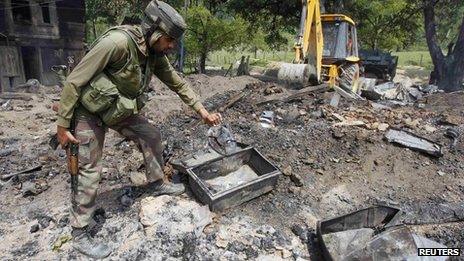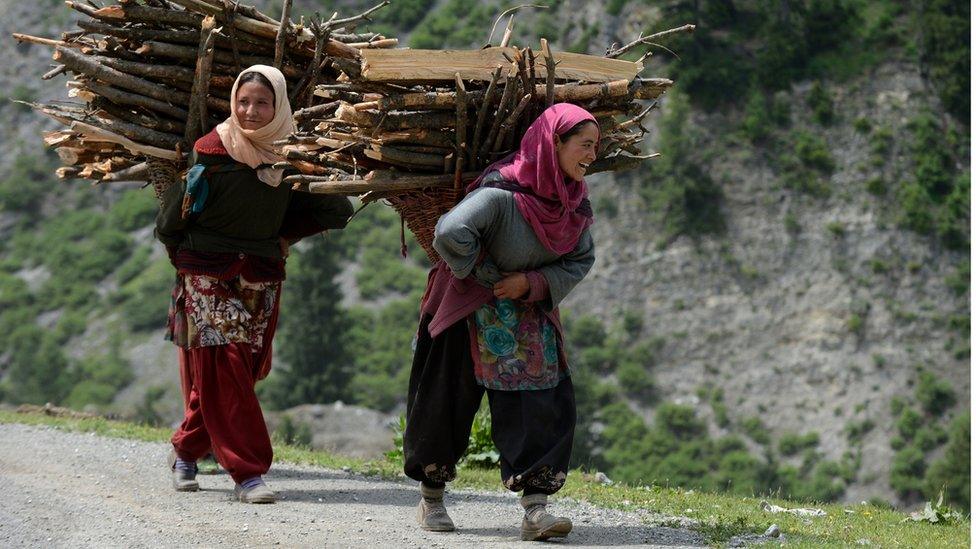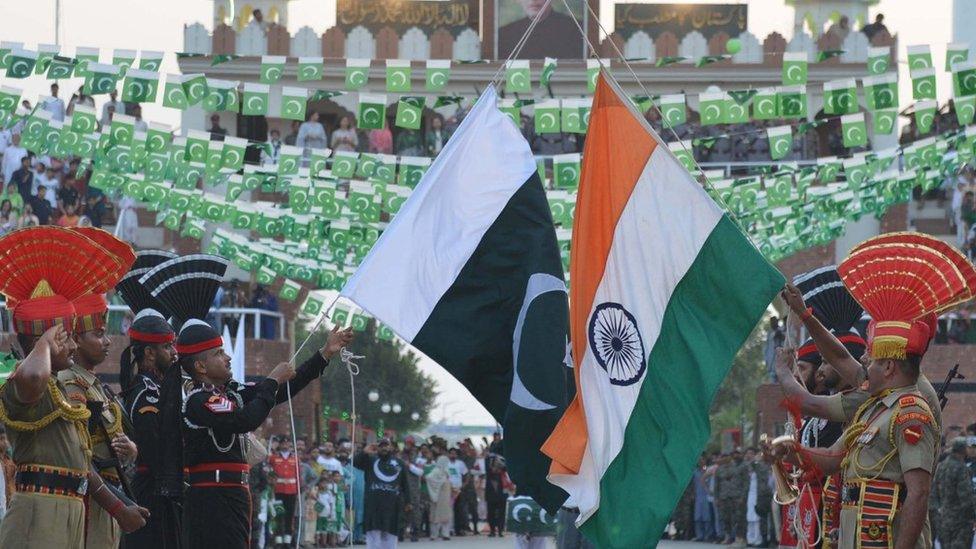Who are the Kashmir militants?
- Published

The militants have been driven out of many their strongholds throughout Indian-administered Kashmir
The insurgency in Indian-administered Kashmir today is a shadow of the uprising of the mid-1990s when bombings and shootings were far more commonplace.
Both India and Pakistan acknowledge that the number of militants coming into the territory from Pakistani-administered Kashmir has dwindled significantly.
The Kashmir uprising of the last three decades can perhaps be categorised into two distinct periods - discontent over Delhi's rule surfacing in the 1980s, leading to the rise of groups backed by Pakistan from the early 1990s onwards, and the gradual but dramatic reduction in violence in the territory in recent years.
The influence of militant groups such as Al-Badr Mujahideen, which was once very powerful in the mid-1990s, has now waned to such an extent that it is no longer considered to present a threat.
Another group that has lost influence and power is Jaish-e-Mohammad, launched in 1999 by Maulana Masood Azhar, external, a former militant commander released by India from prison for the 1999 hijacking of an airliner.
It shot to prominence in 2000 for its role in the attack on the Red Fort in Delhi.
But its activities in Kashmir failed to elicit public support, especially after a 2001 car bomb attack on the Kashmir state legislative assembly which killed more than 35 people, all civilians. Like other militant groups, it treated local people harshly and became unpopular for trying to change their social customs.
Correspondents say that what remains of the insurgency today is led by four main groups:
Lashkar-e-Taiba
This Pakistan-based militant group was formed by Hafiz Mohammad Saeed in the early 1990s to put the Kashmir insurgency more firmly into the hands of the Pakistanis.
The group was launched as the militant wing of a charity founded by Mr Saeed in the 1980s to facilitate the induction of foreign militants into the Afghan war against the Russians.
In the late 1990s, LeT emerged as the most dangerous militant group in Kashmir, taking the fight to Indian cities outside of Kashmir including an assault on the Indian parliament in Delhi in 2001, external, and the Mumbai attacks in 2008, external which claimed 165 lives and those of the nine gunmen.
Pakistan banned it in 2002, after which it renamed itself Jamaat-ud Dawa. Mr Saeed publicly distanced himself from LeT activities, though many believe he still commands influence over its rank and file.
It is believed that Pakistan's policy in recent years of scaling down tensions with India caused many LeT cadres to defect to other groups or cease their activities. But the main body of the group remained intact.
Despite a Pakistani ban on militant activity in Kashmir in 2006, its fighters continue to attempt infiltration into Indian-administered Kashmir. These attempts were curtailed however when people living along the Line of Control which divides Indian and Pakistani Kashmir started to hold public protests against their activities.
Given its reputation for being close to Pakistani intelligence, the ISI, many consider LeT to be the only group capable of launching another spectacular attack in India to derail the normalisation in relations between the two countries.
The bulk of LeT's activists are now part of a public campaign in Pakistan against the resumption of Nato overland supplies through Pakistan. Mr Saeed - who was recently put on a US most wanted list - is spearheading this campaign.
Hizbul Mujahideen
Hizbul Mujahideen is considered to be the first militant group that comprised an essentially Kashmiri rank and file membership. It is considered to be pro-Pakistani and was throughout the 1990s the largest of Kashmiri militant groups. Today it is one of a few that still maintain a token presence in Indian Kashmir.
Formed in 1989, Hizbul Mujahideen has had close links with the ISI. It has also been closely linked with Afghan warlord Gulbuddin Hekmatyar, external - at one point the group's fighters received training at his camps in Afghanistan.
In the late 1990s, when the Taliban overran those facilities, they moved to camps in Pakistan's Hazara region and to Pakistani Kashmir.
More recently however it has suffered morale shattering splits, the most damaging of which was in 2001 when Hizbul Mujahideen's top field commander in Indian Kashmir, Majeed Dar, announced a unilateral ceasefire against Indian forces. His move took the Pakistan-based head of the group, Syed Salahuddin, by surprise. The split led to in-fighting and the subsequent assassination of Mr Dar.
While Mr Salahuddin remains in control of the group, he has largely presided over the erosion of its ranks and his ability to keep the insurgency going is now under question.
Hizbul Mujahideen is now confined to a few isolated pockets, with its militants based in mountain hideouts instead of villages over which they formerly held sway.
Harkatul Mujahideen
Harkatul Mujahideen is another pan-Islamic group that once fought the Russians under the command of Jalauddin Haqqani, now the leader of the Haqqani Network based in Pakistan which today is fighting against US-led Nato forces in Afghanistan.
Harkatul Mujahideen is accused of conducting what Western powers described as the first act of terrorism in Kashmir in 1995, when the group - then known as Harkatul Ansar - kidnapped five western tourists.
This provoked the US to ban the group, but it soon renamed itself Harkatul Mujahideen.
It is made up of highly trained and dedicated fighters - mostly Pakistanis, but also Afghans and Arabs.
But its harsh tactics caused its backers within the Pakistani establishment gradually to withdraw support, causing its influence to decline.
The group's leader, Maulana Fazlur Rahman Khalil, still wields some limited influence within local seminaries in Pakistan and was invited to negotiate a ceasefire in the 2007 Red Mosque siege in Pakistan.
More recently, he has sometimes been seen on stage with religious leaders conducting the campaign against Nato's overland supplies in Pakistan.
Jammu and Kashmir Liberation Front
The JKLF is a nationalist secular group that has sought the independence of Kashmir from both India and Pakistan.
Drawing on the popular base of Kashmir's nationalist movement, a bomb attack it carried out in Srinagar on 31 July, 1988 in effect marked the start of the insurgency.
The group was formed as early as 1977, with Amanullah Khan as its head. He and another leader, Yasin Malik, organised resistance to Indian rule with help from the Pakistani military regime of General Zia-ul Haq, who, according to Mr Khan, believed that since Islamabad had failed to wrest control of Kashmir from India, it might as well back a movement for its independence.
However, when the insurgency was successfully launched, Pakistan decided to withdraw support from JKLF and instead back groups that wanted Kashmir's accession to Pakistan.
The JKLF as a result found itself sandwiched between Indian security forces and pro-Pakistan militants. By 1990, much of its cadres had either been dispersed, destroyed or absorbed into other groups. Its leadership also split into factions, some of them renouncing militancy.
These groups are now coming together in a non-violent political movement for the reunification of Pakistani and Indian Kashmir.
- Published10 March

